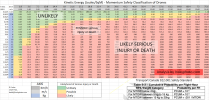AustinDrone
New Member
Thank you! This is exactly what I was looking for.If we are going to get that far into the details then this needs some clarification. Objects don't accelerate at 9.8 m/s² until they reach terminal velocity, and then discontinuously stop accelerating. The rate of acceleration follows from Newton's 2nd Law (F = ma), where F is the weight of the object minus the aerodynamic drag, which is approximately proportional to the square of the air speed v. So,
a = (mg - kv²)/m = g - kv²/m
where k is the constant of proportionality in the form:
k = ρcA/2
where ρ is the air density, A is the effective cross-sectional area and c is a geometric factor, which is approximately unity for a flat(ish) shape. So while the instantaneous initial acceleration of any object is g, it immediately starts to decrease for all v > 0.
If we take the cross-sectional area of a Mavic 2 to be about 25 cm x 25 cm (a conservative estimate including the propellers) and its mass to be 0.9 kg, and the and solve the resulting differential equation, we get the following acceleration, speed and distance as a function of time, which is actually quite consistent with observed falling Mavics.
View attachment 65532
From this I gather that a drone that experiences a critical failure and falls from 100ft would impact the ground at ~25 mph. From 150 or higher, it might impact at about 40 mph. I was looking for this so that I could estimate potential liability due to injury and property damages when flying over stuff (with any necessary waivers, of course).












